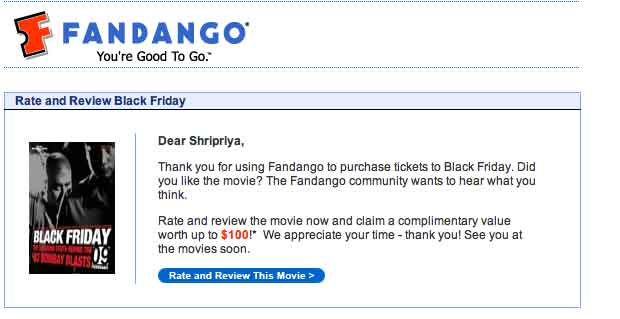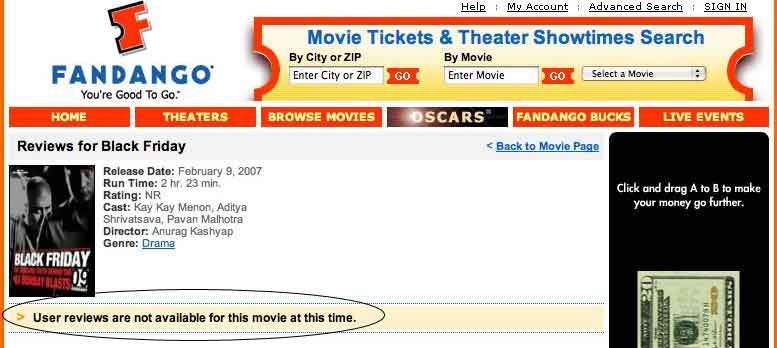The New York Times had a very interesting article on what could happen when a director doesn’t get final cut rights. The final cut of a film refers to the cut/version of the film that is shown to the public.
It is a rare privilege when a studio will give a director final cut because the final cut can determine the economics of a film. A few directors do get/have gotten final cut rights. It is usually the really big name directors who could make their film with any studio. But for most directors this option is just not on the table.
Despite the fact that no one can actually predict which films will do well and which ones won’t, producers and studios spend tons of money on market research. They make a cut of the film and test it on the target audience (ever been recruited at a mall to watch a pre-release movie? That’s the testing). They do a few of these and based on audience reaction and the excruciatingly detailed feedback cards that the viewers fill out, they decide if the movie is funny – does it get laughs at the right places, if it is too long, too short, not enough drama or too much drama. On and on, the lists go. The firms that moderate these focus screenings then crunch the data and give the studio input.
I have two problems with this kind of testing:
1. Is there any proof out there that there is any sort of predictive accuracy? From what I hear, the testing agencies don’t release data on how their test compared to market actuals. I don’t know if anyone is measuring them and holding their feet to the fire to be accountable for their recommendations.
2. New products, especially stunningly new ones that break out of the mold, may not do well. Sometimes you have to assume you know what the consumer wants better than he/she does. Case in point in the technology world – Apple and the iPod.
According to the NY Times piece, the final cut tussle has gotten ugly for director Julie Taymor on the film Across The Universe:
After Ms. Taymor delivered the movie to Joe Roth, the film executive whose production company, Revolution Studios, based at Sony, is making the Beatles musical, he created his own version without her agreement. And last week Mr. Roth tested his cut of the film, which is about a half-hour shorter than Ms. Taymor’s 2-hour-8-minute version.
As a director, you feel the film is your baby. You are the visionary, you make it happen. You sweat over it. You did all the pre-production, worked night and day, dealt with all the on-set issues, managed a large crew and made a great film! Wow. Of course you are going to feel protective. (I felt that way for my tiny little short done on three intense days of shooting – just imagine the intensity of a feature!) Someone else making a cut of your film, disregarding your own cut, has got to hurt badly.
While I completely empathize with the director, find the way that studios and marketers test films very odd and don’t necessarily agree with that process, I also feel that the passion of being a director can cause you to be too attached to certain scenes. And very passionate directors, who have made wrong calls can scar producers forever:
Mr. Roth, who vowed never again to allow a director final cut after the disastrous 2003 Martin Brest movie “Gigli,†said that the various versions were testing well, but that he had a responsibility to find the most successful incarnation. “It’s ‘show’ and it’s ‘business,’ †he said.
Despite my wanting to be fully on the side of the director, Roth has a point – of course films need to be commercially successful. That’s what allows the director to make the next one.
Since I am not emotionally embroiled in such a fight, it is easier for me to see both sides and I am quite torn on this issue. In the ideal world, the director will try to detach themselves a little and the producer would never go behind his director’s back. And it always seems like it is a good idea to put a project away and come back to it in a while, but that is rarely possible when you need a return on investment as soon as possible.
At the end of the day, everyone probably compromises to make the film a reality. And Roth and Taymor (who also directed Titus and Frida) will likely compromise too, despite the fact that it is going to be harder after all the public words and Taymor’s consideration of removing her name from the film (the most drastic step a director has in her arsenal) :
Mr. Roth said he believed that the current tensions would be worked out, and that Ms. Taymor would find the best, final version of the film somewhere between his own and her last cut.
:
Ms. Taymor herself struck a more conciliatory note in her statement: “I only hope that we will be able to complete the film we set out to make.â€
This is such a tough part of the film-making process – this is the reason you see all the director’s cuts of movies where the director has his/her say many years after the official release.
I am not sure if there is any blanket way to solve this – it probably all comes down to the relationship you have with your director or producer. So, be very, very careful who you get into bed with – even if they flash a lot of money in your face!


